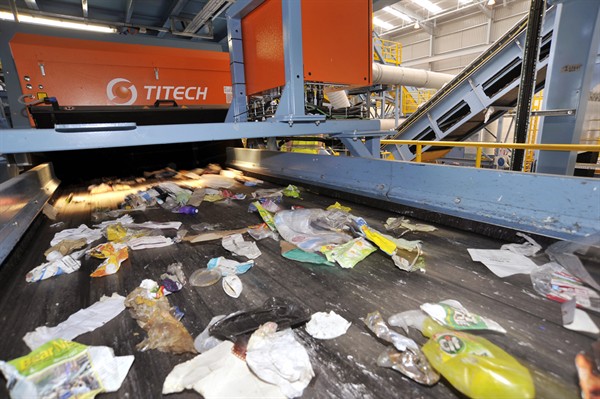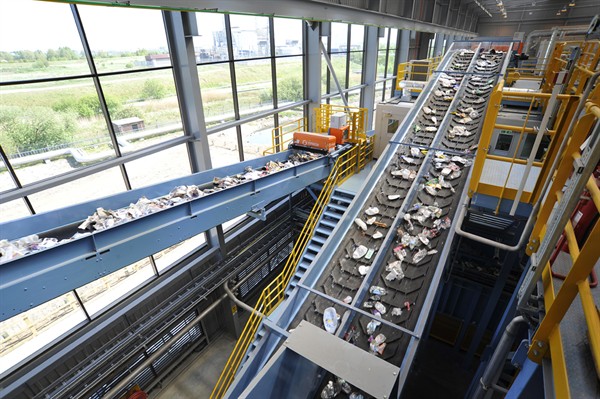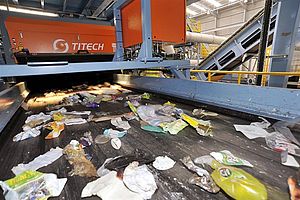An estimated 13.2 million tonnes of paper and board products were consumed in the UK in 2008, with 67% of this paper recovered for recycling1. Currently recycling rates for are generally very good and are improving, yet there are issues with the quantity and quality of paper for reuse in paper mills.
Materials recovery facilities (MRFs) have improved enormously in recent years. In terms of paper and board products, MRFs can now achieve levels of up to 70% recovery and contamination levels as low as 2-3%. However, the majority of UK MRFs have been designed to consider the performance and profitability across a number of material streams rather than focussing on one stream, such as paper. This can lead to a dichotomy between what the reprocessing industry is capable of producing and what is demanded in terms of quality and quantity by some end users.
As a specialist paper manufacturer, UPM has experienced difficulties in securing a consistent supply of high quality recycled fibre for use in its paper mills. It therefore took the ground breaking decision to develop its own MRF at UPM Shotton paper mill in North Wales.
Sorting Requirements
UPM is one of the UK’s largest recyclers of used newspapers and magazines, reusing more than 3.2M tonnes per year in its graphic papers production. UPM Shotton consumes approximately 640,000 tonnes of recovered fibre to produce up to 500,000 tonnes of newsprint per year. Securing sufficient recovered fibre of a consistently high quality is therefore vital to its continued success.
David Green, Technical Director at UPM Shotton, explains: “We took the strategic decision to develop our own MRF so that we had some degree of control over the supply chain and the purity of the recovered fibre coming into the paper mill. As far as we are aware, nothing like this has been tried before, but to us it was the next logical step in securing the long-term future of our business.”
The UPM Shotton MRF represents an investment of some £17 million and will take in commingled waste from a number of sources to produce up to 120,000 tonnes of recovered fibre per year – around 20 per cent of UPM Shotton’s requirements. However, UPM has set some ambitious recovery and purity targets: they are aiming for a 99.9 per cent recovery rate and contamination levels of under 1% for browns (cardboard) and around 1% for all other materials.
These targets far exceed anything that current MRFs are achieving, so UPM took a number of steps to ensure that its new MRF would deliver these efficiencies. ”Our background is in process engineering, so the way we approached procurement seemed logical to us, although it may be rather unusual to the waste management industry,” says David Green.
Knowing what output material parameters were needed, UPM conducted detailed market research to find out what could deliver the required quality of recovered paper. The research included visiting reference sites throughout Europe, Canada and the USA as well as conducting a series of meetings with potential plant builders and equipment companies prior to the formal tender process.
“By the time we came to the final tender process, it was clear which companies had really understood what it was we were trying to achieve,” says David Green.
Canadian company Machinex ultimately won the contract to build the flagship MRF. It has designed and installed over 200 turnkey facilities in partnership with leading MRFs in Canada, the United States and Northern Europe.
“We visited Machinex reference sites which were delivering close to UPM expectations for paper recovery using traditional mechanical techniques,” says David Green. “We were therefore confident that, with the addition of optical sorting equipment, they would be able to achieve 90 per cent recovery of paper and the required 99% purity rates for the recovered fibre.”
Rather than accept a third party recommendation for optical sorting systems, UPM undertook their own research for this aspect of the new MRF too. Having reviewed a number of options, they concluded that Titech sensor-based sorting systems were the best available and specified that Titech technology had to be incorporated into the tender in order for it to be considered.
Adding Value
Titech paper sorting systems differ significantly in their approach to materials identification from many other options on the market. Most paper sorting systems use an RGB camera for paper sorting, yet this process has issues with separating materials effectively because it identifies only by colour. This can lead to misidentification.
For example, when paper and cardboard become damp their appearance can change significantly and the camera can no longer distinguish between damp paper and dry cardboard, which leads to contamination. Titech systems use an optical sorting technique known as NIR spectroscopy, which identifies specific materials by their physical properties, making the wetness of the paper immaterial and significantly improving accuracy.
“We were very impressed with what we had heard about Titech systems, but we subjected them to the same scrutiny as everyone else,” says David Green. “Having obtained detailed technical data and seen Titech systems in action, we were convinced that they would be critical to achieving the recovery rates and purity levels that our paper process demanded.”
Ten systems have been installed at UPM Shotton plus a sensor-only unit for quality control. Six systems are dedicated to maximising the recovery and purity of the paper line, while a further four Titech systems are used to target plastics for recovery. Materials entering the MRF follow a relatively straightforward recovery process, as follows:
1) Large and 3D items are removed and grading occurs using a mixture of mechanical and screening techniques.
2) The materials then pass under four Titech systems in sequence, which remove browns and other contaminants from the paper line.
3) A further optical sorting system then screens the non-paper line to recover any paper that has been pulled off with other materials. This is fed back into the paper line.
4) A final pass under the sixth Titech system then sorts the smaller items such as envelopes.
Quality control is an essential part of the UPM Shotton MRF process, as David Green explains: “The MRF has been built adjacent to the recovered paper warehouse which makes it logistically very efficient. However, strict controls are required to make sure that nothing coming in from the MRF side can compromise the high quality end product.”
Once the paper has been automatically sorted, it passes through a handpicking section for visual checking. As a final check, a Titech sensor unit is positioned on the conveyor that takes the recovered paper through to the paper mill. This does not extract anything, but acts purely as a quality control unit and prevents any paper with unacceptable levels of contamination passing through to the paper processing side.
Because the recovered paper is fed into the paper mill directly, there is no need to store it. This increases the potential storage capacity for input materials for the MRF and allows the plant to operate 24/7.
As well as providing the mill with a secure supply of recovered fibre, the UPM Shotton MRF supports UPM’s zero waste to landfill policy. It will also provide an additional revenue stream through the recovery of other materials besides paper. There is an emphasis on quality here too, with UPM aiming to supply recyclers with secondary materials, such as plastic, that require no further reprocessing.
Paper sorting systems
An estimated 13.2 million tonnes of paper and board products were consumed in the UK in 2008, with 67% of this paper recovered for recycling1. Currently recycling rates for are generally very good and are improving, yet there are issues with the quantity and quality of paper for reuse in paper mills. Materials recovery facilities (MRFs) have improved enormously in recent years. In terms of paper and...
- by Tomra Sorting Solutions AS
- February 24, 2012
- 496 views



















